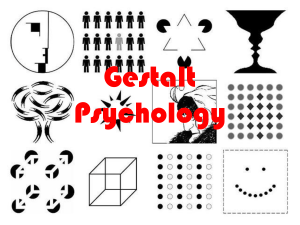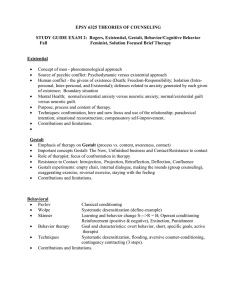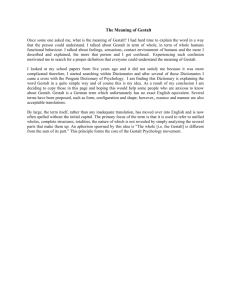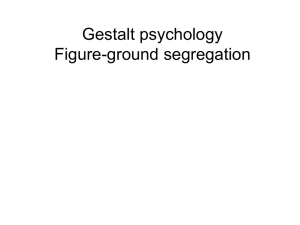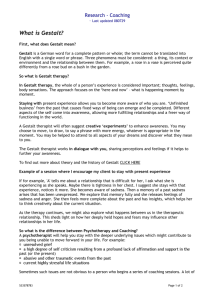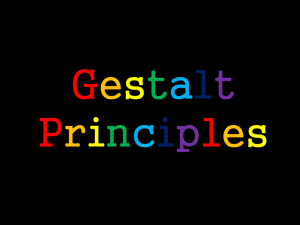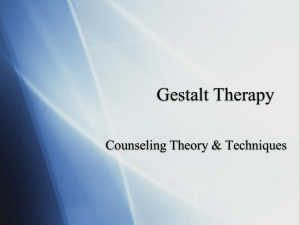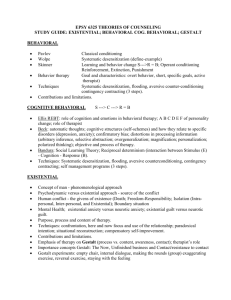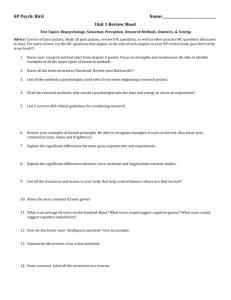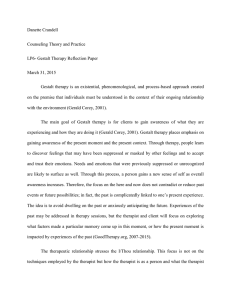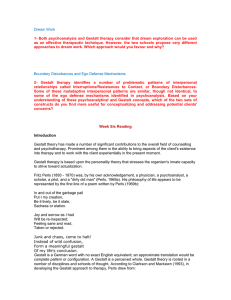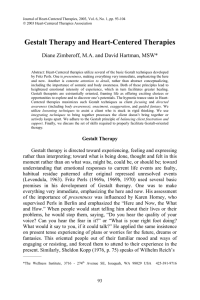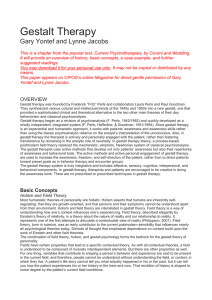Gestalt psychotherapy
advertisement
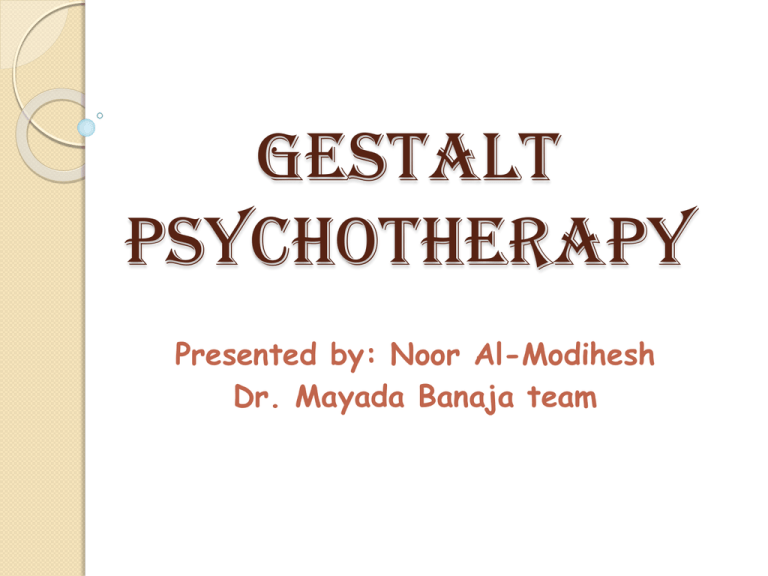
Gestalt psychotherapy Presented by: Noor Al-Modihesh Dr. Mayada Banaja team History . Purpose. Theoretical concepts. Skills in Gestalt. Assessment. Treatment phases. Who is Gestalt ? So , what's the meaning ? Gestalt BY ; Frederick (Fritz) and Laura Perls in the 1940s seems to be more “animated” than mere form or object, implying a sort of "reaching out" to its environment knowledge of an "other,” a sort of "dialogue" between me and that "other," and a sort of connection that draws me into that "dialogue.“ A presentation of a "Gestalt" suggests the involvement of my perception and awareness in an act of identification of reality. A Gestalt can thus be identified as a kind of knowledge. Gestalt is A structured entity that is more than & different from its parts. It is the foreground figure that stands out from its ground, it exists” Laura Perls It encompasses existential & person-centered. Promotes awareness in HERE & NOW The present receive more attention than past Exploring & experiencing emotions are integral to treatment. Purpose : To help people got aware about those neglected parts & restore wholeness, integration & balance . Important theoretical concepts: 1. View of humankind : people are basically good & had capacity to cope with their lives BUT !! At times need help. 2. Wholeness & integration : we are not a summation of parts BUT !! coordination. 3.integrating polarities : need for homeostasis viewed people &their world either good or bad. what is important is integrating body & mind. 4.Integrating figures & ground : the world around us is ground. 5. Ego boundary : definition in relation to environment (in relation to situation) 6.Awareness : Awareness is a form of experience that may be loosely defined as being in touch with one's own existence, with what is The person who is aware knows what he does & how he does it, that he has alternatives and that he chooses to be he is. As its best , non-verbal knowing what is happening HERE & NOW. Self awareness . exercise 7.Responsibility : accepting responsibility for our own lives , people must make their own choices rather than allowing others. Theraputic alliance : I-thou relationship. Both fully present in here & now. Paradoxical principle of change: change occur when one becomes what he is & not when he tries to become what he is not. Observation without judgment. Listen & help to find own way. Assessment : Not diagnosis. Process of how he is behaving now. Client in process. Clients relational patterns. Field condition. Client in process: Embodied process : description in room including movement , voice…. Support system; his setting in room & confidence. Belief system ; introjects , meaning of circumstances.. Client relational patterns: Describe his way in relating to you . Note any transferential response. Field conditions; Cultural factors,race…. So in conclusion , Gestalt diagnosis is an understanding or assessment of all ways that client makes meaning or contact with his world. Treatment phases: Beginning : Working alliance. Awareness Dialogic relation. Cultural differences. Planning for special conditions. Clearing the ground: Introjects. Unfinished business. Self-expression Experiment with new behavior. Existential encounter: Re-owning lost parts, Live & move. self-limiting core beliefs. Live with courage of uncertainty Spiritual meaning. Integration : Re-organize with new insights Improve relational contact Connecting to community Accepting anxiety with newness Responsibility for choices. Ending ; Loss of relation Re-cycling of issues Celebrating what achieved Accepting things not achieved Planning for future crises Experimenting : Identifying emerging figure or theme. Suggesting: (safe emergency) , has right to refuse. Grading amount of challenge. If difficult start with emotions Remind of support Change situation. RULE : convey non judgmental attitude to experiment & avoid being invested. No right outcome Use language carefully by emphasis on statements Using what, how BUT never why? ‘I’ statement . The present tense Large Group exercise : Unfinished business; Traumatic events not achieved resolution. Need great awareness with enough support. Examining the impasse ---reactivate. Trace clearest memory. Where is the maximum energy . Encourage to bring feelings,thougths…. Identify interruptions. Working with imagination. Working with introjects : identify opposite polarity, two chair & roleplay…. Dreams: Royal road to integration. It is existential messenger. Projections of some aspects of dreamer, or relation with therapist. Ask to present it in present form. As a real story! Express it non verbally( body posture , moving…. Retell dream from other perspective.. Create dialogues bet. Characters in dream Use different outcome. Is it a message about therapist? Fantasy : Make people more aware. Help to be more productive. Represent projections or aspects of person. Encourage people to be part of dream. Ending : Tasks for ending: Raise awareness , remind what brought him . Acknowledge & celebrate what has been achieved . Acknowledge what hasn’t achieved yet. Feed back. Conducting reviews : Original contract. Check if relevant . New issues emerged. What aspects helped him. Any change in contract. Offer f\u at least after 3-6 months. Summary : Gestalt focuses on unification & wholeness of a person through feeling, senses & fantasies. This awareness yields personality changes by means of problem solving & identifying impasses. It is a here & now experimental modality which is a process for individual to be in touch with him self. Future & past important BUT their significance is in relation to their influence on present. Inquiry by how , what & NEVER why.. It is when client assume responsibility for what they feel & think (the greatest value) Gestalt modality specify that person passes through 5 levels of neurosis: 1. Phony layer : not being them selves. 2. Phobic level : fear of seeing who one really is 3. Impasse level ; stuck in dependency position where he seek for others to make decision. 4. Implosive level: accept responsibility & develop courage to face their personal defenses as they come close to real selves ( full awareness) 5.Explosive level : letting go of the false image the individual has created. It promotes in dependence rather than dependence on therapist & the most provocative technique is Empty Chair. Thank you
